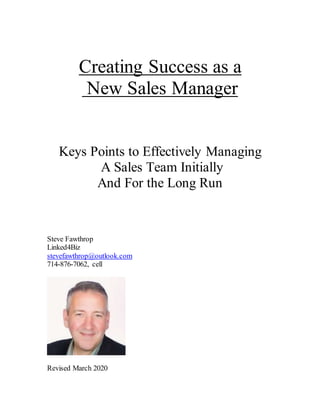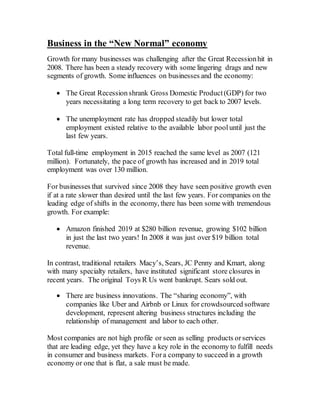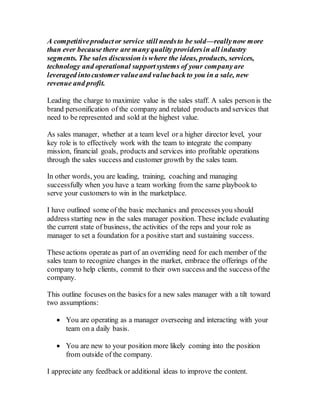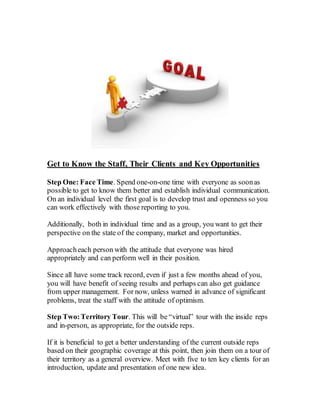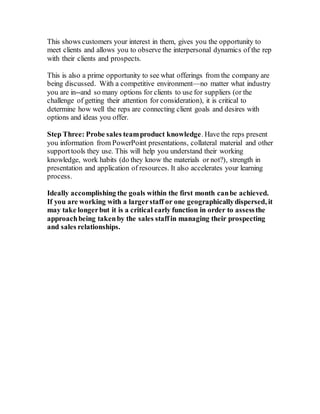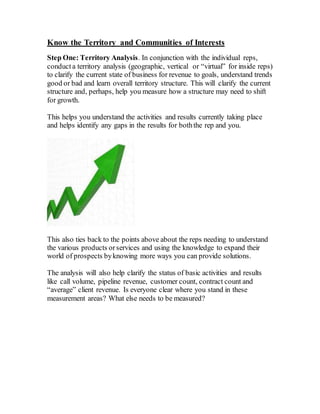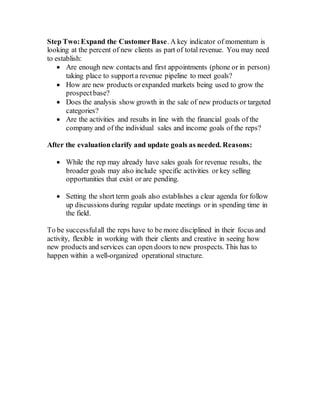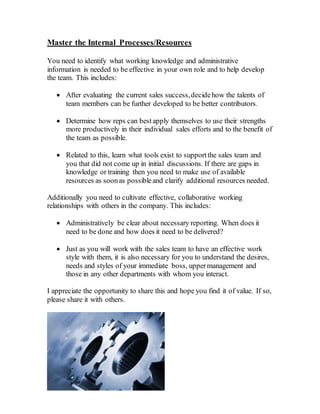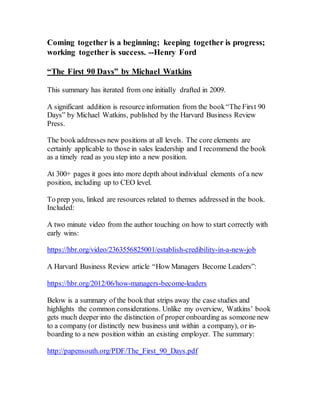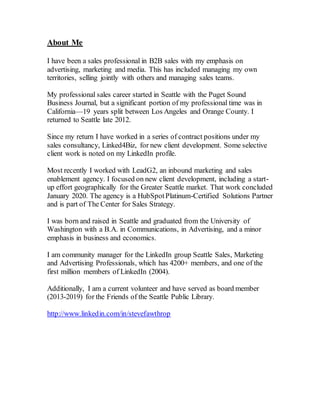Creating Success as a New Sales Manager
- 1. Creating Success as a New Sales Manager Keys Points to Effectively Managing A Sales Team Initially And For the Long Run Steve Fawthrop Linked4Biz stevefawthrop@outlook.com 714-876-7062, cell Revised March 2020
- 2. Business in the “New Normal” economy Growth for many businesses was challenging after the Great Recessionhit in 2008. There has been a steady recovery with some lingering drags and new segments of growth. Some influences on businesses and the economy:  The Great Recession shrank Gross Domestic Product(GDP) for two years necessitating a long term recovery to get back to 2007 levels.  The unemployment rate has dropped steadily but lower total employment existed relative to the available labor pool until just the last few years. Total full-time employment in 2015 reached the same level as 2007 (121 million). Fortunately, the pace of growth has increased and in 2019 total employment was over 130 million. For businesses that survived since 2008 they have seen positive growth even if at a rate slower than desired until the last few years. For companies on the leading edge of shifts in the economy, there has been some with tremendous growth. For example:  Amazon finished 2019 at $280 billion revenue, growing $102 billion in just the last two years! In 2008 it was just over $19 billion total revenue. In contrast, traditional retailers Macy’s, Sears, JC Penny and Kmart, along with many specialty retailers, have instituted significant store closures in recent years. The original Toys R Us went bankrupt. Sears sold out.  There are business innovations. The “sharing economy”, with companies like Uber and Airbnb or Linux for crowdsourced software development, represent altering business structures including the relationship of management and labor to each other. Most companies are not high profile or seen as selling products orservices that are leading edge, yet they have a key role in the economy to fulfill needs in consumer and business markets. For a company to succeed in a growth economy or one that is flat, a sale must be made.
- 3. A competitiveproductor service still needsto be sold—reallynow more than ever because there are manyquality providersin all industry segments. The sales discussion is where the ideas, products, services, technology and operational supportsystems of your companyare leveraged intocustomer valueand valueback to you in a sale, new revenue and profit. Leading the charge to maximize value is the sales staff. A sales personis the brand personification of the company and related products and services that need to be represented and sold at the highest value. As sales manager, whether at a team level or a higher director level, your key role is to effectively work with the team to integrate the company mission, financial goals, products and services into profitable operations through the sales success and customer growth by the sales team. In other words, you are leading, training, coaching and managing successfully when you have a team working from the same playbook to serve your customers to win in the marketplace. I have outlined some of the basic mechanics and processes you should address starting new in the sales manager position. These include evaluating the current state of business, the activities of the reps and your role as manager to set a foundation for a positive start and sustaining success. These actions operate as part of an overriding need for each member of the sales team to recognize changes in the market, embrace the offerings of the company to help clients, commit to their own success and the success ofthe company. This outline focuses on the basics for a new sales manager with a tilt toward two assumptions:  You are operating as a manager overseeing and interacting with your team on a daily basis.  You are new to your position more likely coming into the position from outside of the company. I appreciate any feedback or additional ideas to improve the content.
- 4. Get to Know the Staff, Their Clients and Key Opportunities Step One: Face Time. Spend one-on-one time with everyone as soonas possible to get to know them better and establish individual communication. On an individual level the first goal is to develop trust and openness so you can work effectively with those reporting to you. Additionally, both in individual time and as a group, you want to get their perspective on the state of the company, market and opportunities. Approacheach person with the attitude that everyone was hired appropriately and can perform well in their position. Since all have some track record, even if just a few months ahead of you, you will have benefit of seeing results and perhaps can also get guidance from upper management. For now, unless warned in advance of significant problems, treat the staff with the attitude of optimism. Step Two:Territory Tour. This will be “virtual” tour with the inside reps and in-person, as appropriate, for the outside reps. If it is beneficial to get a better understanding of the current outside reps based on their geographic coverage at this point, then join them on a tour of their territory as a general overview. Meet with five to ten key clients for an introduction, update and presentation of one new idea.
- 5. This shows customers your interest in them, gives you the opportunity to meet clients and allows you to observe the interpersonal dynamics of the rep with their clients and prospects. This is also a prime opportunity to see what offerings from the company are being discussed. With a competitive environment—no matter what industry you are in--and so many options for clients to use for suppliers (or the challenge of getting their attention for consideration), it is critical to determine how well the reps are connecting client goals and desires with options and ideas you offer. Step Three: Probe sales teamproduct knowledge. Have the reps present you information from PowerPoint presentations, collateral material and other supporttools they use. This will help you understand their working knowledge, work habits (do they know the materials or not?), strength in presentation and application of resources. It also accelerates your learning process. Ideally accomplishing the goals within the first month canbe achieved. If you are working with a largerstaff or one geographicallydispersed, it may take longerbut it is a critical early function in order to assessthe approachbeing takenby the sales staffin managing their prospecting and sales relationships.
- 6. Know the Territory and Communities of Interests Step One: Territory Analysis. In conjunction with the individual reps, conduct a territory analysis (geographic, vertical or “virtual” for inside reps) to clarify the current state of business for revenue to goals, understand trends good or bad and learn overall territory structure. This will clarify the current structure and, perhaps, help you measure how a structure may need to shift for growth. This helps you understand the activities and results currently taking place and helps identify any gaps in the results for boththe rep and you. This also ties back to the points above about the reps needing to understand the various products orservices and using the knowledge to expand their world of prospects byknowing more ways you can provide solutions. The analysis will also help clarify the status of basic activities and results like call volume, pipeline revenue, customer count, contract count and “average” client revenue. Is everyone clear where you stand in these measurement areas? What else needs to be measured?
- 7. Step Two:Expand the CustomerBase. A key indicator of momentum is looking at the percent of new clients as part of total revenue. You may need to establish: ď‚· Are enough new contacts and first appointments (phone or in person) taking place to supporta revenue pipeline to meet goals? ď‚· How are new products orexpanded markets being used to grow the prospectbase? ď‚· Does the analysis show growth in the sale of new products or targeted categories? ď‚· Are the activities and results in line with the financial goals of the company and of the individual sales and income goals of the reps? After the evaluationclarify and update goals as needed. Reasons: ď‚· While the rep may already have sales goals for revenue results, the broader goals may also include specific activities or key selling opportunities that exist or are pending. ď‚· Setting the short term goals also establishes a clear agenda for follow up discussions during regular update meetings or in spending time in the field. To be successfulall the reps have to be more disciplined in their focus and activity, flexible in working with their clients and creative in seeing how new products and services can open doors to new prospects. This has to happen within a well-organized operational structure.
- 8. Master the Internal Processes/Resources You need to identify what working knowledge and administrative information is needed to be effective in your own role and to help develop the team. This includes: ď‚· After evaluating the current sales success,decidehow the talents of team members can be further developed to be better contributors. ď‚· Determine how reps can bestapply themselves to use their strengths more productively in their individual sales efforts and to the benefit of the team as possible. ď‚· Related to this, learn what tools exist to supportthe sales team and you that did not come up in initial discussions. If there are gaps in knowledge or training then you need to make use of available resources as soonas possibleand clarify additional resources needed. Additionally you need to cultivate effective, collaborative working relationships with others in the company. This includes: ď‚· Administratively be clear about necessary reporting. When does it need to be done and how does it need to be delivered? ď‚· Just as you will work with the sales team to have an effective work style with them, it is also necessary for you to understand the desires, needs and styles of your immediate boss, uppermanagement and those in any other departments with whom you interact. I appreciate the opportunity to share this and hope you find it of value. If so, please share it with others.
- 9. Coming together is a beginning; keeping together is progress; working together is success. --Henry Ford “The First 90 Days” by Michael Watkins This summary has iterated from one initially drafted in 2009. A significant addition is resource information from the book“The First 90 Days” by Michael Watkins, published by the Harvard Business Review Press. The bookaddresses new positions at all levels. The core elements are certainly applicable to those in sales leadership and I recommend the book as a timely read as you step into a new position. At 300+ pages it goes into more depth about individual elements of a new position, including up to CEO level. To prep you, linked are resources related to themes addressed in the book. Included: A two minute video from the author touching on how to start correctly with early wins: https://hbr.org/video/2363556825001/establish-credibility-in-a-new-job A Harvard Business Review article “How Managers Become Leaders”: https://hbr.org/2012/06/how-managers-become-leaders Below is a summary of the bookthat strips away the case studies and highlights the common considerations. Unlike my overview, Watkins’ book gets much deeper into the distinction of proper onboarding as someone new to a company (or distinctly new business unit within a company), or in- boarding to a new position within an existing employer. The summary: http://papensouth.org/PDF/The_First_90_Days.pdf
- 10. Additional Resources I have written a number of blog posts on LinkedIn related to sales, management, leadership, personal development and other topics. Some related to sales and management: Commentary on some key points in the book“Fanatical Prospecting”: http://bit.ly/2joWaPI 6 biases that may be holding back your success in closing more sales, from "The Challenger Sale": http://bit.ly/1MnjyrC Trust and the Leadership Gap: http://linkd.in/1zxvI60 Know the difference between management and leadership. Observations from Dr. John Kotter of Harvard: http://bit.ly/2yTxNDk Ego vs. Healthy Debate. Keep the focus productive: http://bit.ly/2fDnY26 Understanding talents and strengths: http://bit.ly/1VKEMUN From others: Harvard Business Review blog on seven personality traits of a top sale person: http://bit.ly/1Ofd1Rs Stephan Schiffman on sales coaching: http://bit.ly/20iswMu While older, I recommend his books “Getting to Closed” (emphasis on territory management) and “Ask Questions, Make Sales.” For recruitment and hiring: The high costof hiring mistakes: http://bit.ly/1P34i57
- 11. About Me I have been a sales professional in B2B sales with my emphasis on advertising, marketing and media. This has included managing my own territories, selling jointly with others and managing sales teams. My professional sales career started in Seattle with the Puget Sound Business Journal, but a significant portion of my professional time was in California—19 years split between Los Angeles and Orange County. I returned to Seattle late 2012. Since my return I have worked in a series of contract positions under my sales consultancy, Linked4Biz, for new client development. Some selective client work is noted on my LinkedIn profile. Most recently I worked with LeadG2, an inbound marketing and sales enablement agency. I focused on new client development, including a start- up effort geographically for the Greater Seattle market. That work concluded January 2020. The agency is a HubSpotPlatinum-Certified Solutions Partner and is part of The Center for Sales Strategy. I was born and raised in Seattle and graduated from the University of Washington with a B.A. in Communications, in Advertising, and a minor emphasis in business and economics. I am community manager for the LinkedIn group Seattle Sales, Marketing and Advertising Professionals, which has 4200+ members, and one of the first million members of LinkedIn (2004). Additionally, I am a current volunteer and have served as board member (2013-2019) for the Friends of the Seattle Public Library. http://www.linkedin.com/in/stevefawthrop

